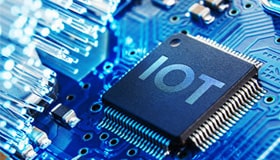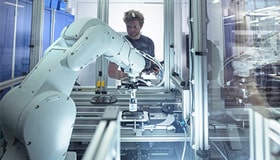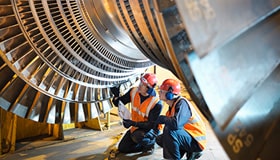Capacitors: Essential components for electronic marvels
Introduction
Capacitors are one of the building blocks of electronics. They are essential to many applications. As a component, capacitors are commonly used for storing energy, regulating voltage levels, power conditioning, electronic noise filtering, and signal coupling or decoupling. Thus, the wide use of capacitors makes them an integral component of multiple industries. Various industrial systems use these devices, including power supplies and motor controllers, and communication systems, amongst others. This guide introduces capacitors, including their basic operation, types, and applications.
Capacitor basics
What is a capacitor?
A capacitor is a passive electronic component. In this component, an insulating material or layer separates two or multiple pieces of conducting material. This insulating layer is called a dielectric. A capacitor can store energy in an electrostatic field generated by a potential difference across the conductors. Thus, when a conductor is subjected to a voltage, a positive charge will collect on one plate of the capacitor, and the other plate will be negatively charged. The ratio of this electric charge and the potential difference (voltage) is called the capacitance in farads (F).

Figure 1: A basic capacitor connected to a battery
When a capacitor is connected to any voltage source or battery, a current will flow from the battery's negative terminal to the plate nearest to this terminal. The second becomes the negatively-charged plate. According to Coulomb's Law, the electrons on the other plate move at the same time toward the battery's positive terminal, and this plate thus becomes the positive one. The capacitor is considered fully charged when the negative plate shows a saturation of electrons in the negative plate, and an electric field is developed across the plates.
A Farad can be a substantial capacitance; even a 0.001F (1 millifarad -- 1mF) is a big capacitor. Most capacitors are rated in the pico- (10-12) to microfarad (10-6) range. Learn more about capacitor basics.
| Prefix name | Abbreviation | Weight | Equivalent farads |
|---|---|---|---|
| Picofarad | pF | 10-12 | 0.000000000001 F |
| Nanofarad | nF | 10-9 | 0.000000001 F |
| Microfarad | µF | 10-6 | 0.000001 F |
| Millifarad | mF | 10-3 | 0.001 F |
| Kilofarad | kF | 103 | 1000 F |
Capacitor types
Capacitors can be of either fixed or variable capacitance. Fixed capacitors have a fixed and nonadjustable capacitance value.
The user can adjust Variable capacitors (aka tuning capacitors due to their applications in antenna and radio tuning), employing either electronic or mechanical means. Mechanical variable capacitors are made up of two sets of overlapping metal plates: one that rotates and is controlled by a shaft (rotor) and a second that is a stationary set (stator). Another form of the mechanical variable capacitor is the trimmer capacitor, which has a mica dielectric between two plates. The trimmer capacitor must be adjusted with a screw.
Based on their features, fixed capacitors are sub-classified into several types, each with its own particular characteristics and uses. Some of the most common types as listed in the following table.Learn more about different capacitor types
| Category | Features | ||
|---|---|---|---|
| Ceramic Capacitors | SMD Type | Multilayer Ceramic Chip Capacitors (MLCC)  | SMD-type capacitors having laminated dielectric ceramics possess Superior high-frequency characteristics and heat resistance. These capacitors can be divided into two types depending on their dielectrics: Type 1 products (temperature compensating) have minute variations in capacitance due to temperature, whilst Type 2 products ( having high dielectric constants) can support relatively large capacitance values but have considerably higher rates of change due to temperature than Type 1. |
| Lead Type | MLCC with Dipped Radial Lead | These are resin-coated laminated ceramic chip capacitors bonded to lead wires. They have the characteristics of laminated ceramic chip Capacitors. The lead wires provide benefits like reduced mechanical and thermal stress and insulation. A coat of resin offers such capacitors with temperature shielding effects. They are also extremely effective in measures against capacitor "singing." | |
Disc Type Capacitors with Lead (High Voltage Ceramic Capacitors) | These disc-shaped ceramic capacitors with lead wires can support medium to high voltages to a maximum of 6 kV. Their outer resin coating is compliant with halogen-free specifications. The lineup includes a safety-standardized product series, with obtained safety standard certifications from various countries. The series is also the AEC-Q200 standard complaint needed for passive components in all automotive applications. | ||
| Aluminum electrolytic capacitors |  | These capacitors utilise an aluminum oxide film and electrolyte solution. They feature large capacitance but many also have properties of having a polarity. It is essential that these types of capacitor are connected the correct way around (biased), otherwise they can be damaged. TDK offers a varied lineup of aluminum electrolytic capacitors that includes radial lead, axial lead, screw terminal, and snap-in terminal types. | |
| Film capacitors |  | These capacitors have self-healing capability. They use plastic film as dielectric with an ultra-thin vacuum-evaporated metallization layer. They can endure a broad range of AC and DC voltages with high currents and temperatures. Film capacitors are thus suitable for applications ranging from a few hundred watts to several megawatts. | |
| Ultra-high voltage ceramic capacitors |  | These are ceramic capacitors and can support ultra-high voltages of up to 50 kV. They are highly stable due to their use of paraelectric ceramics. Ultra-High Voltage Ceramic Capacitors are also reliable regarding voltage, and their simple structures provide excellent mechanical strength. | |
| Electric double-Layer capacitors(EDLC / supercapacitors) |  | EDLCs are special capacitors. They share characteristics that are between a capacitor and a battery (secondary battery). These are found in power storage devices. EDLCs cause ions to stick to the surface of electrolyte-soaked activated carbon electrodes. The Electric Double Layer thus formed can accumulate an electric charge and gives these power storage devices with extraordinarily large energy density and capacitance. | |
Capacitor selection criteria / how to select the right capacitor
Several factors must be considered when there is a need to select a suitable capacitor:
- Size – This applies to both capacitance and physical volume. Capacitors are available in all sizes. They can be the biggest component in a circuit or can be tiny. Greater capacitances usually need a larger capacitor.
- Maximum voltage – Each capacitor has a maximum rated voltage. A few capacitors may be rated for 1.5V, while others can be rated for 100V. The capacitor will be destroyed if the maximum voltage is exceeded.
- Leakage current - Capacitors are not foolproof. Every device, through its dielectric, can leak a minuscule current from one terminal to the other. Such tiny current loss (generally nano amps or less) is termed leakage. If leakage occurs, the energy stored in the capacitor will slowly drain.
- Equivalent series resistance (ESR) – Capacitor terminals are never completely conductive and always have low resistance (usually less than 0.01Ω). When a flood of current flows through the cap, generating heat and power loss, such minimal resistance creates difficulty.
Tolerance - Capacitors can't be made to have an exact, precise capacitance. Although each capacitor will be rated for its nominal capacitance, the actual value may vary from ±1 percent to ±20 percent of the desired value, depending on the type.
A typical example is shown in the following figure. The three-digit code printed on the body identifies the capacitor's value in the picofarad. Letter codes indicate their tolerance value, such as J = 5%, K = 10%, or M = 20%. For example, the preceding ceramic disc capacitor with a marking of 154 indicates that there are 15 and 4 zeros of a picofarad, or 150,000 pF (150nF).

Figure 2: Tolerance value of ceramic disc capacitor
Dielectric material: The dielectric material has a significant role during capacitor selection. Various dielectric material groups have different characteristics, disadvantages, and advantages. Although absent in this table, the air is occasionally used as a dielectric in high-voltage applications.
Type Examples Characteristics/advantages Disadvantages Paper Paper / oil-impregnated paper Almost obsolete; occasionally used in a few high-voltage applications Large size, susceptible to moisture and subsequent degradation Film Polyester film or mylar Generally replaced paper capacitors, greater moisture resistance, and small size Low-temperature stability and hazardous dielectric heating when utilized in RF applications Mica Mica Durable, excellent temperature stability Susceptible to moisture; high cost Glass Glass Similar to mica, reliable and stable, with better radiation resistance High cost Polymer Polystyrene, polycarbonate, polyamide, PP, polyester General purpose construction; suitable for a variety of applications, including high voltage and RF Relatively low-temperature resistance; bigger size; can be easily damaged by pulses or transients Electrolytic Aluminum/tantalum electrolytic High capacitance to volume ratio; stable, reliable, durable; miniature construction High cost; Chance of violent explosion or burst when overloaded Table: Dielectric characteristics
Standards and compliance: Capacitors may be manufactured in compliance with applicable standards, inclusive of:
- IEC 60384 (Refers to fixed capacitors for use in electronic equipment; 26 parts)
- IEC 60418 (Variable capacitors; 4 parts)
- MIL 14409 (Variable capacitor performance; 19 parts) and more
RoHS: The European union adopted the Restriction of Hazardous Substances Directive (RoHS) in 2003. Although RoHS products are known to be "lead-free," the directive also limits the use of mercury, cadmium, hexavalent chromium, polybrominated diphenyl ether, and polybrominated biphenyls in electronic or electrical products. The RoHS directive was created to reduce medical hazards in developing countries flooded with "high-tech trash."

Form factor and mounting: Capacitors are mostly manufactured as Through Hole (THT) or Surface Mount (SMT) devices.
- Through hole
Through hole, components have long leads. These leads pass through holes on a printed circuit board (PCB) and are soldered onto the opposite side. THT mounting guarantees a tough mechanical connection. The Through Hole products, by necessity, must be proportionately large. Now Surface Mount Technology (SMT) has largely replaced THT.
Through hole capacitors may feature one of many lead arrangements:
- Axial leads extend from the ends of the capacitor and along the axis and not from the sides.
- Radial leads extend from one end or side of the capacitor instead of both ends.
- Flying leads extend horizontally.

- Surface mount
Surface mount devices use short leads, flat contacts, BGAs, or other terminations to be mounted directly onto a PCB. SMT devices are much smaller than THT capacitors. Since drilled holes are unnecessary, SMTs can be easily and cheaply assembled.

- Through hole
Common applications of capacitors
- AC coupling/DC blocking – the capacitor permits only AC signals to transport from one section of a circuit to another whilst it blocks any DC static voltage. The primary use of the capacitor is to separate the AC and DC components of the signal. This method necessitates that the capacitor's impedance remains sufficiently low. The capacitor-rated voltage must be more than the peak voltage across the capacitor. The capacitor will ensure reliability as it can withstand the supply rail voltage.
- Power supply decoupling – The capacitor can separate one section of a circuit from another. When an incoming line signal passes via a transformer and a rectifier, it decouples. The resultant waveform is not smooth and might range from zero to the maximum voltage. When applied to a circuit, this may not work because a DC voltage is usually required.
- Filter AC noise from DC circuits – The capacitor must eliminate any alternating current signals on a DC bias point, power rail, or other nodes that must be free of a certain changing signal. It must also be able to withstand the supply voltage and simultaneously provide and absorb the amounts of current caused by rail noise.
- Audio signal filtering – The RF performance of the capacitor must be evaluated. At lower frequencies, its performance might vary. Ceramic capacitors are commonly employed in this application because of their high self-resonant frequency, particularly the extremely tiny surface mount capacitors with no leads that might create inductance.
Newark has partnered with many different suppliers catering to a wide range capacitors portfolios such as aluminum electrolytic capacitors, arc suppression / snubber networks, ceramic capacitors, film capacitors, mica capacitors, niobium oxide capacitors, polymer capacitors, RF capacitors, supercapacitors, tantalum capacitors, transmission line metal insulator metal (MIM) capacitors, trimmer capacitors and more.







